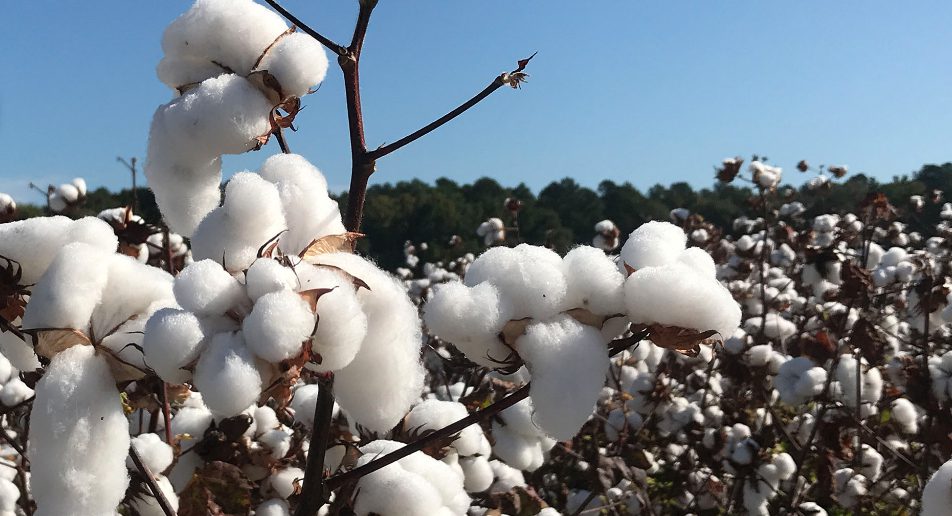CLEMSON – Cotton has been around for about 8,000 years and has become an important part of the Earth’s economy. To ensure cotton can adapt to the planet’s ever-changing environment and continue to grow as a cash crop, a Clemson University geneticist is working with researchers across the United States to determine how to breed for more sustainable cotton varieties.

Results of their study can be found in the latest issue of Nature Genetics magazine, a monthly journal publishing the best research from across the field of genetics.
Chris Saski, an associate professor of systems genomics in Clemson’s Plant and Environmental Sciences Department, is part of the team that is studying how cotton DNA can be used to quickly breed new varieties that can withstand climatic changes and are resistant to diseases, pests and other threats. DNA is the genetic code that determines the characteristics of all living beings.
“Cotton has an annual economic impact of $500 billion worldwide,” Saski said. “But it currently is threatened by several devastating diseases, such as fusarium wilt and nematode infection, that impact growing areas, including the southeastern United States.”
During the study, the team used the latest advances in genome (DNA) sequencing. The researchers were able to create the highest-quality DNA sequence ever for a polyploid crop and gain new understandings of the evolution and diversification of cotton. Polyploid crops make up a significant portion of the major food and fiber crops of the world and include cotton, wheat, potato, cotton, peanut, citrus, and brassica oilseeds such as rape, canola and Camelina.
The team compared the genome sequences of the two domesticated cottons (upland and pima) to several wild species. They investigated genes for fiber traits and disease resistance, as well as genes and DNA differences that lead to other traits.
“We believe this sequence, or DNA roadmap, will provide the foundation for more sustainable crops to be grown,” Saski said.
Saski’s role in the study was to analyze the R-genes, or resistance genes, in two domesticated and three wild cotton species.
“Understanding the origin and diversification of these genes can help cotton breeders and geneticists better understand and exploit their role in disease resistance,” he said.
[vid origin=”youtube” vid_id=”de5oZk9qKIg” size=”medium” align=”left”]
The evolutionary histories of the domesticated cottons can be found in their DNA, Saski said. The researchers found limited genetic diversity exists in cottons and DNA modifications, or the epigenome, may be responsible for regulation of traits.
“We also discovered the genes that are involved in fiber, the major selected trait in cotton, have similar gene expression profiles in the two domesticated cotton varieties, which suggests domestication drives parallel expression similarities,” he said. “We also found wild species have rich backgrounds and diversified R-genes, and may be used to add genetic diversity to elite breeding lines.”
Research for the study took place in Saski’s molecular laboratory. He used Clemson’s Palmetto Cluster to analyze his data. The Palmetto Cluster is a high-performance computing system available to all Clemson students, employees and research partners.
Sarah Holladay is a master’s student from Florence who is studying plant and environmental sciences with a focus in agronomy. She is working with Clemson Extension Service cotton specialist Michael Jones and USDA-Agricultural Research Service cotton geneticist Todd Campbell at the Clemson Pee Dee Research and Education Center to determine if pima cotton can be productive in South Carolina after an almost 100-year absence. Holladay believes pima could benefit the state’s cotton farmers and said studies like this are important
“Understanding the genetics of traits between and within species could help us understand why pima and upland perform so differently, despite being closely related,” Holladay said. “Research such as this will benefit farmers by increasing the usefulness of high-quality pima materials for breeding and agronomic development.”
Cotton plays a major role in the world economy. Global cotton production provides income for about 100 million families across almost 150 countries. In South Carolina, 300,000 acres of cotton were planted in 2019 for an economic value of more than $141 million.
Upland cotton is the most common species in South Carolina, with efforts to bring back Pima cottons underway. Saski said this study will help researchers determine how to breed these cotton species to be better suited for South Carolina farmers.
“The environment is constantly changing,” Saski said. “Some cotton varieties may become less able to adapt to these changes and production may be lessened. We need to be able to use the latest advances in molecular biology and biotechnology to rapidly breed new cotton varieties that farmers can grow and be profitable.”
-END-
Get in touch and we will connect you with the author or another expert.
Or email us at news@clemson.edu

